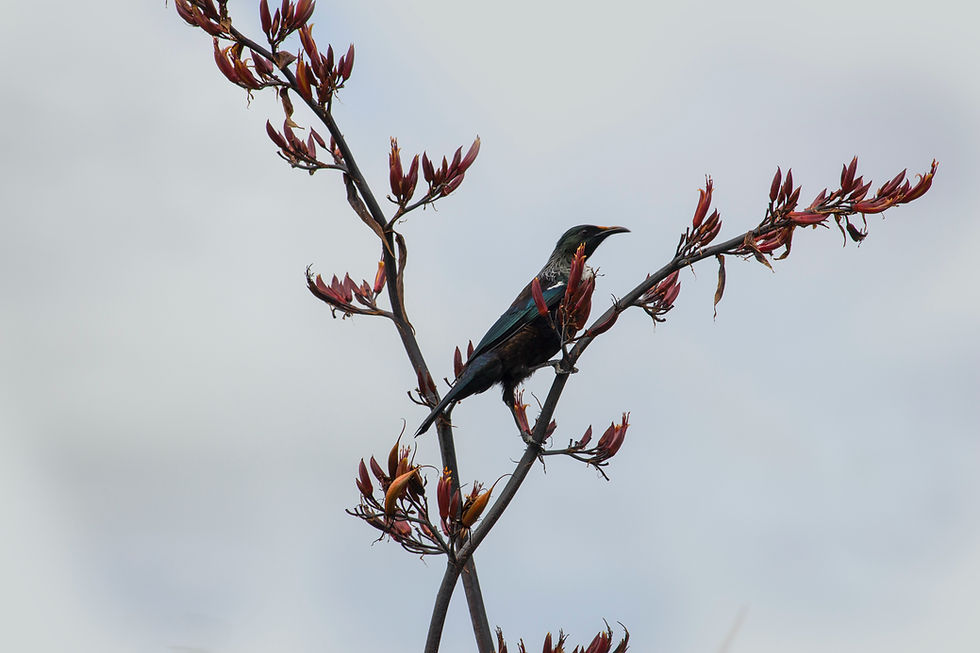Tis The Season for Tussock!
- Nadia Crighton
- Apr 9
- 4 min read
Why Nassella Tussock Is a Growing Threat to Our Environment?

As the seasons shift, so too does the focus of landowners and restoration teams across New Zealand. Right now, it's tussock season – a crucial time to tackle one of our most invasive and damaging grass species: Nassella Tussock (Nassella Trichotoma).
At Native Restorations, we work across the South Island – from Marlborough to Nelson and Kaikōura – helping landowners, farmers, and councils identify, manage, and remove this persistent weed. But not all tussocks are a problem. So what’s the difference? Why does Nassella Tussock need to go? And what role do councils and landowners play in the solution?
Let’s dig in!
What Is Nassella Tussock – And Why Is It a Problem?
Nassella Tussock is an invasive, needle-like grass with a dense white fibrous root system and the ability to grow up to 1 metre tall. A single mature plant can produce over 100,000 seeds each year, and those seeds can lie dormant in the soil for up to 20 years, making eradication incredibly difficult once it's established.
Its impacts include:
Smothering and replacing native species
Reducing the quality and productivity of farmland
Increasing fire risk due to dense dry foliage
For a great overview of nassella tussock's appearance and why it’s so problematic, see the Otago Regional Council
Native vs Invasive Tussock: What’s the Difference?
Not all tussocks are bad. In fact, Native Tussocks – like Snow Tussock (Chionochloa Spp.) – play an important role in our ecosystems. They stabilise soil, provide habitats for native species, and help maintain water quality.
Native tussocks are typically:
Larger, slower-growing
Ecologically valuable and long-lived (some over 200 years old!)
Found in alpine and subalpine regions
In contrast, invasive tussocks like Nassella were introduced accidentally in the late 1800s and have spread aggressively in drier grassland areas like Marlborough and Canterbury. They are considered a noxious weed and subject to strict council control measures.
How to Tell the Difference Between Native and Invasive Tussocks
Not all tussocks are created equal—and there's a simple hands-on test that can help you tell them apart.
Run your fingers along the leaves.
Native Tussocks (like Chionochloa species) feel smooth when you move your hand up and down the leaf.
Invasive Tussocks, such as Nassella Tussock, feel rough and almost scaly, especially when you slide your hand upwards.
That rough, sandpapery texture is a key sign you’re dealing with an invasive species—and a potential threat to native ecosystems and pasture.
When in doubt, always check before you plant—or better yet, ask the experts. At Native Restorations, we can help you identify and remove invasive species while promoting the growth of true New Zealand natives.
How Did Nassella Tussock Get Here?
Nassella Tussock (Nassella trichotoma) is native to South America, where it naturally grows in parts of Argentina, Uruguay, and southern Brazil. Nassella Tussock was first recorded in New Zealand in 1867. By the 1930s, it had become such a serious issue that the Nassella Tussock Act was passed in 1946, introducing legal requirements for its removal.
Over time, without control, the plant has spread rapidly across eastern New Zealand, thriving particularly in regions like Marlborough, Canterbury, and parts of Otago.
What Are the Rules for Landowners?
Control of Nassella Tussock is not just best practice – in many regions, it’s the law.
Marlborough District Council
Landowners in Marlborough must destroy all Nassella Tussock plants on their properties before they seed. Failure to comply can result in enforcement action under the Regional Pest Management Plan.
Marlborough resources
Nassella Tussock Control Programme:
Canterbury – Environment Canterbury (ECan)
Landowners are required to remove all Nassella Tussock before seeding each year. Specific dates vary depending on your location.
Otago Regional Council
ORC also runs a strict biosecurity programme and requires landowners to eradicate any Nassella Tussock on their land.
How Native Restorations Can Help
At Native Restorations, we’ve seen the impacts of Nassella Tussock firsthand – and we know how to beat it.
Our team works with landowners, councils, and conservation groups to:
Identify invasive species across varied terrain – including steep, remote areas
Remove Nassella Tussock using methods like grubbing, spraying, and controlled access
Restore native biodiversity by planting local species and maintaining weed-free areas
Support ongoing maintenance and compliance with council regulations
We’ve spent over 20 years protecting native plants and wildlife across the Marlborough, Nelson, and Kaikōura regions. No terrain is too tough – and no infestation too challenging.
👉 Learn more about what we do at: https://www.native-restorations.com
Why Acting Now Matters
The longer Nassella Tussock is left unchecked, the harder it is to control. Early action helps:
Reduce long-term control costs
Protect native species
Increase farm productivity
Comply with local council regulations
Spring and early summer are the ideal seasons to act – before seeds mature and spread. Whether you’ve got a small block or a large farm, now is the time to get on top of it.
Need Help Controlling Tussock?
If you're in the Marlborough, Nelson, or Kaikōura regions and need support with invasive weed control – get in touch with Native Restorations today.
Together, we can restore balance to your land and protect Aotearoa’s unique natural heritage – one tussock at a time.




Comments